sensor Seat Ibiza SC 2009 Owner's manual
[x] Cancel search | Manufacturer: SEAT, Model Year: 2009, Model line: Ibiza SC, Model: Seat Ibiza SC 2009Pages: 257, PDF Size: 6.61 MB
Page 26 of 257

Seat belts
24Belt tension devices*Function of the belt tension device
During a frontal collision, the seat belts on the front seats are
retracted automatically.The seat belts for the front occupants are equipped with belt tension devices.
Sensors will trigger the belt tension devices during severe head-on, lateral
and rear collisions only if the seat belt is being worn. This retracts and
tightens the seat belts, reducing the forward motion of the occupants.
The belt tension device can be triggered only once.
The belt tension devices will not be triggered in the event of light frontal and
side collisions, if the vehicle overturns, or in situations where no large forces
act on the front, side or rear of the vehicle.
Note
•If the belt tension devices are triggered, a fine dust is produced. This is
normal and it is not an indication of fire in the vehicle.•The relevant safety requirements must be observed when the vehicle or
components of the system are scrapped. A qualified workshop is familiar with
these regulations and will be pleased to pass on the information to you.Service and disposal of belt tension devicesThe belt tension devices are components of the seat belts that are installed
in the seats of your vehicle. If you work on the belt tension devices or remove
and install parts of the system when performing other repair work, the seat
belt may be damaged. The consequence may be that, in the event of an acci-
dent, the belt tension devices function incorrectly or not at all. So that the effectiveness of the belt tension device is not reduced and that
removed parts do not cause any injuries or environmental pollution, regula-
tions, which are known to the qualified workshops, must be observed.
WARNING
•If repairs are not carried out by a professional, or if the belt tension
devices are used incorrectly, the risk of severe or fatal injuries increases.
The belt tension devices may fail to trigger or may trigger in the wrong
circumstances.•Never attempt to repair, adjust, remove or install parts of the belt
tension devices or seat belts.•The belt tension device and seat belt including its automatic retractor
cannot be repaired.•Any work on the belt tension devices and seat belts, including the
removal and refitting of system parts in conjunction with other repair work,
must be performed by a qualified workshop only.•The belt tension devices will only provide protection for one accident
and must be changed it they have been activated.
IbizaSC_EN.book Seite 24 Mittwoch, 16. September 2009 12:11 12
Page 63 of 257

Cockpit61
Safety First
Controls and equipment
Practical tips
Technical Data
Brake system* / handbrake
The warning lamp lights up if the handbrake is applied, if the
brake fluid level falls too low or if there is a fault in the brake
system.
This warning lamp
lights up if
•If the handbrake is applied•If the brake fluid level is too low ⇒page 188•If there is a fault in the brake system
This warning lamp can light up together with the anti-lock brake system
warning lamp.WARNING
•If the brake warning lamp does not go out, or if it lights up when
driving, the brake fluid level ⇒page 188, “Brake fluid” in the reservoir is
too low. Risk of accident. Stop the vehicle and do not drive on. Obtain tech-
nical assistance.•If the brake warning lamp
lights up together with the ABS warning
lamp
, the control function of the ABS could be out of action. This could
cause the rear wheels to lock quickly when you brake. This could cause the
rear to break away. Risk of skidding. Stop the vehicle and seek technical
assistance.
Cruise control system*
The warning lamp comes on when the cruise control system
is switched on.The warning lamp
lights up when the cruise control system is switched on.
Further notes on the cruise control system ⇒page 143.
Tyre pressure*
The tyre monitor
5) co m p a r e s w h e e l r e v o l u t i o ns a n d wi t h t h is i n f o r m a t i o n , t h e
diameter of each wheel using the ESP sensors. If the diameter of a wheel
changes, the tyre monitor indicator lights . The wheel diameter changes
when:
•Tyre pressure is insufficient.5)Depending on the model version
Fig. 38 Centre console:
tyre monitor system
button
IbizaSC_EN.book Seite 61 Mittwoch, 16. September 2009 12:11 12
Page 73 of 257

Unlocking and locking71
Safety First
Controls and equipment
Practical tips
Technical Data
Deactivation
Rotate the key inserted in the lock cylinder twice towards the locking direc-
tion.
To activate the system using the remote control, press the lock button on the
remote twice in less than five seconds.
On deactivating the “Safe” system, the alarm volumetric sensor is also deac-
tivated.
With the “Safe” switched off, doors can be opened from the interior but not
from the exterior.
See “Selective unlocking system*”
“Safe” status
On the driver's door, there is a visible light indicator which shows the “Safe”
system status.
We will know that “Safe” system is activated by the flashing light indicator.
The indicator will flash on all vehicles, fitted and nor fitted with an alarm, until
they unlock.
Remember:
Safe activated with or without an alarm:
Continuous flashing of warning
light.
Safe deactivated without an alarm: The indicator remains off.
Safe deactivated with an alarm: The indicator remains off.
WARNING
No one should remain inside the vehicle if the “Safe” mechanism is acti-
vated because opening the doors will not be possible in case of emergency
neither from the inside nor the outside. Danger of death. Passengers could
become trapped inside in case of emergency.
Selective unlocking system*
This system allows the unlocking of either just the driver's
door or all the vehicle.Driver's door unlock button
Unlock once. Use either the key or the remote control.
Once the key is inserted in the lock cylinder, rotate once in the unlock direc-
tion. The driver's door will remain without “Safe” and unlocked. See Anti-theft
Alarm chapter for vehicles fitted with an alarm ⇒page 77.
Using the remote control, press the unlock button on the remote once. The
“Safe” system for all the vehicle is deactivated, only the driver's door is
unlocked and both the alarm and the light indicator are also turned off.
Unlocking all doors and the boot
The unlock button on the remote must be pressed twice so that all doors
and the boot can be opened.
Press twice within 5 seconds to deactivate the “Safe” system for all vehicle,
to unlock all doors and to use the boot. The indicator and the alarm (only vehi-
cles fitted with one) are turned off.
Unlocking the boot
See ⇒page 79.
Activating the selective unlocking system*
With the door open, insert a key into the start cylinder and start the ignition.
Insert the other key into the driver's door lock and turn in the direction of
opening for at least 3 seconds. The indicators will flash twice.
Deactivating the selective unlocking system*
With the door open, insert a key into the start cylinder and start the ignition.
Insert the other key into the driver's door lock and turn in the direction of
locking for at least 3 seconds. The indicators will flash once.
IbizaSC_EN.book Seite 71 Mittwoch, 16. September 2009 12:11 12
Page 79 of 257
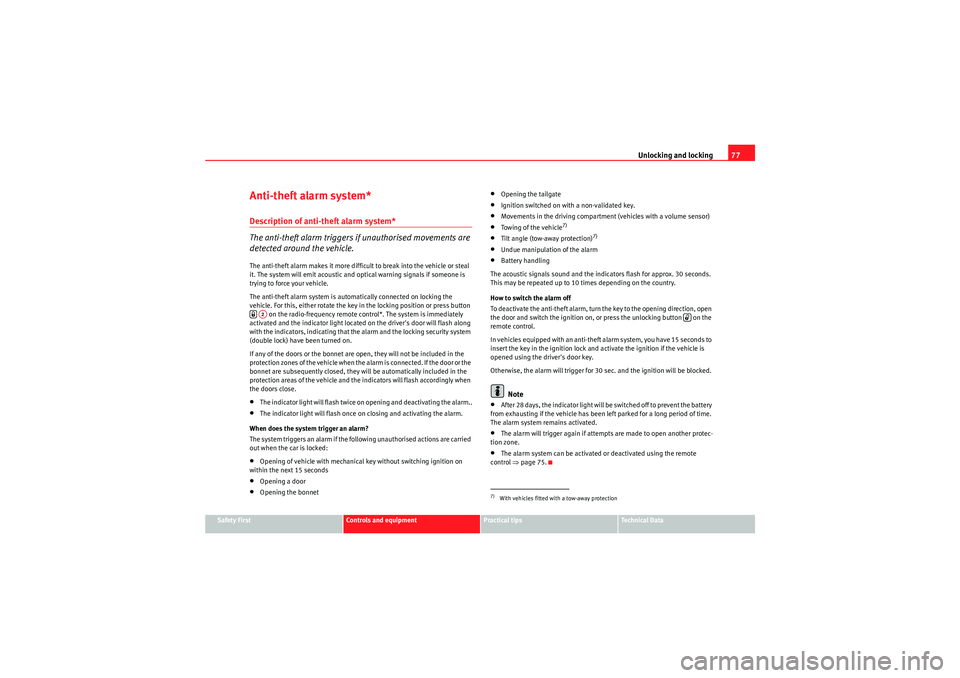
Unlocking and locking77
Safety First
Controls and equipment
Practical tips
Technical Data
Anti-theft alarm system*Description of anti-theft alarm system*
The anti-theft alarm triggers if unauthorised movements are
detected around the vehicle.The anti-theft alarm makes it more difficult to break into the vehicle or steal
it. The system will emit acoustic and optical warning signals if someone is
trying to force your vehicle.
The anti-theft alarm system is automatically connected on locking the
vehicle. For this, either rotate the key in the locking position or press button
on the radio-frequency remote control*. The system is immediately
activated and the indicator light located on the driver's door will flash along
with the indicators, indicating that the alarm and the locking security system
(double lock) have been turned on.
If any of the doors or the bonnet are open, they will not be included in the
protection zones of the vehicle when the alarm is connected. If the door or the
bonnet are subsequently closed, they will be automatically included in the
protection areas of the vehicle and the indicators will flash accordingly when
the doors close.•The indicator light will flash twice on opening and deactivating the alarm..•The indicator light will flash once on closing and activating the alarm.
When does the system trigger an alarm?
The system triggers an alarm if the following unauthorised actions are carried
out when the car is locked:•Opening of vehicle with mechanical key without switching ignition on
within the next 15 seconds•Opening a door•Opening the bonnet
•Opening the tailgate•Ignition switched on with a non-validated key.•Movements in the driving compartment (vehicles with a volume sensor)•Towing of the vehicle
7)
•Tilt angle (tow-away protection)
7)
•Undue manipulation of the alarm•Battery handling
The acoustic signals sound and the indicators flash for approx. 30 seconds.
This may be repeated up to 10 times depending on the country.
How to switch the alarm off
To deactivate the anti-theft alarm, turn the key to the opening direction, open
the door and switch the ignition on, or press the unlocking button on the
remote control.
In vehicles equipped with an anti-theft alarm system, you have 15 seconds to
insert the key in the ignition lock and activate the ignition if the vehicle is
opened using the driver's door key.
Otherwise, the alarm will trigger for 30 sec. and the ignition will be blocked.Note
•After 28 days, the indicator light will be switched off to prevent the battery
from exhausting if the vehicle has been left parked for a long period of time.
The alarm system remains activated.•The alarm will trigger again if attempts are made to open another protec-
tion zone.•The alarm system can be activated or deactivated using the remote
control ⇒page 75.
A2
7)With vehicles fitted with a tow-away protection
IbizaSC_EN.book Seite 77 Mittwoch, 16. September 2009 12:11 12
Page 80 of 257
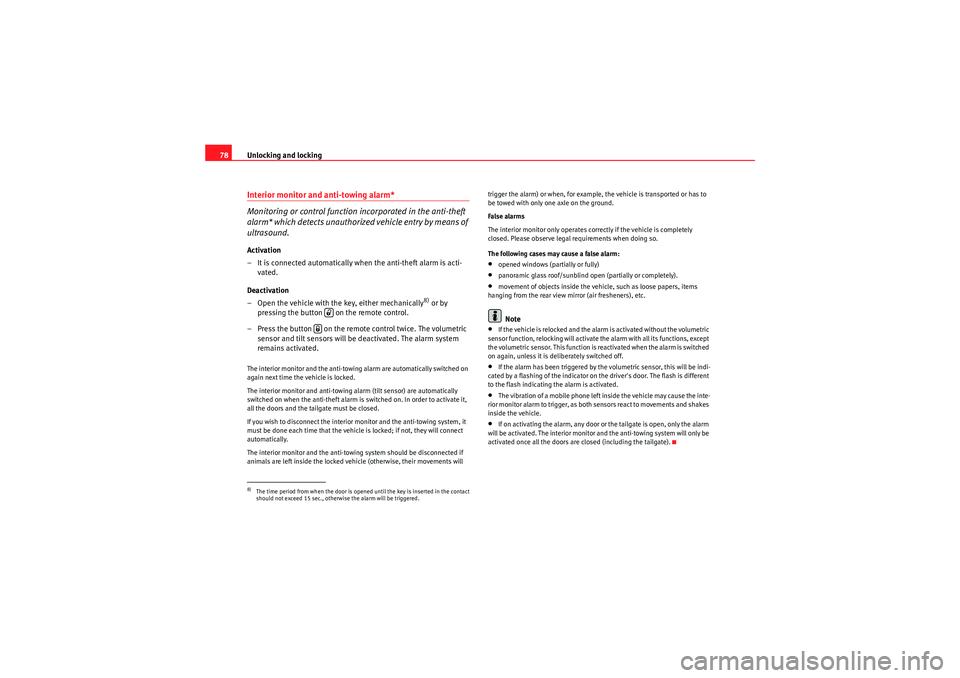
Unlocking and locking
78Interior monitor and anti-towing alarm*
Monitoring or control function incorporated in the anti-theft
alarm* which detects unauthorized vehicle entry by means of
ultrasound.Activation
– It is connected automatically when the anti-theft alarm is acti-
vated.
Deactivation
– Open the vehicle with the key, either mechanically
8) or by
pressing the button on the remote control.
– Press the button on the remote control twice. The volumetric sensor and tilt sensors will be deactivated. The alarm system
remains activated.
The interior monitor and the anti-towing alarm are automatically switched on
again next time the vehicle is locked.
The interior monitor and anti-towing alarm (tilt sensor) are automatically
switched on when the anti-theft alarm is switched on. In order to activate it,
all the doors and the tailgate must be closed.
If you wish to disconnect the interior monitor and the anti-towing system, it
must be done each time that the vehicle is locked; if not, they will connect
automatically.
The interior monitor and the anti-towing system should be disconnected if
animals are left inside the locked vehicle (otherwise, their movements will trigger the alarm) or when, for example, the vehicle is transported or has to
be towed with only one axle on the ground.
False alarms
The interior monitor only operates correctly if the vehicle is completely
closed. Please observe legal requirements when doing so.
The following cases may cause a false alarm:
•opened windows (partially or fully)•panoramic glass roof/sunblind open (partially or completely).•movement of objects inside the vehicle, such as loose papers, items
hanging from the rear view mirror (air fresheners), etc.Note
•If the vehicle is relocked and the alarm is activated without the volumetric
sensor function, relocking will activate the alarm with all its functions, except
the volumetric sensor. This function is reactivated when the alarm is switched
on again, unless it is deliberately switched off.•If the alarm has been triggered by the volumetric sensor, this will be indi-
cated by a flashing of the indicator on the driver's door. The flash is different
to the flash indicating the alarm is activated.•The vibration of a mobile phone left inside the vehicle may cause the inte-
rior monitor alarm to trigger, as both sensors react to movements and shakes
inside the vehicle.•If on activating the alarm, any door or the tailgate is open, only the alarm
will be activated. The interior monitor and the anti-towing system will only be
activated once all the doors are closed (including the tailgate).
8)The time period from when the door is opened until the key is inserted in the contact
should not exceed 15 sec., otherwise the alarm will be triggered.
IbizaSC_EN.book Seite 78 Mittwoch, 16. September 2009 12:11 12
Page 97 of 257
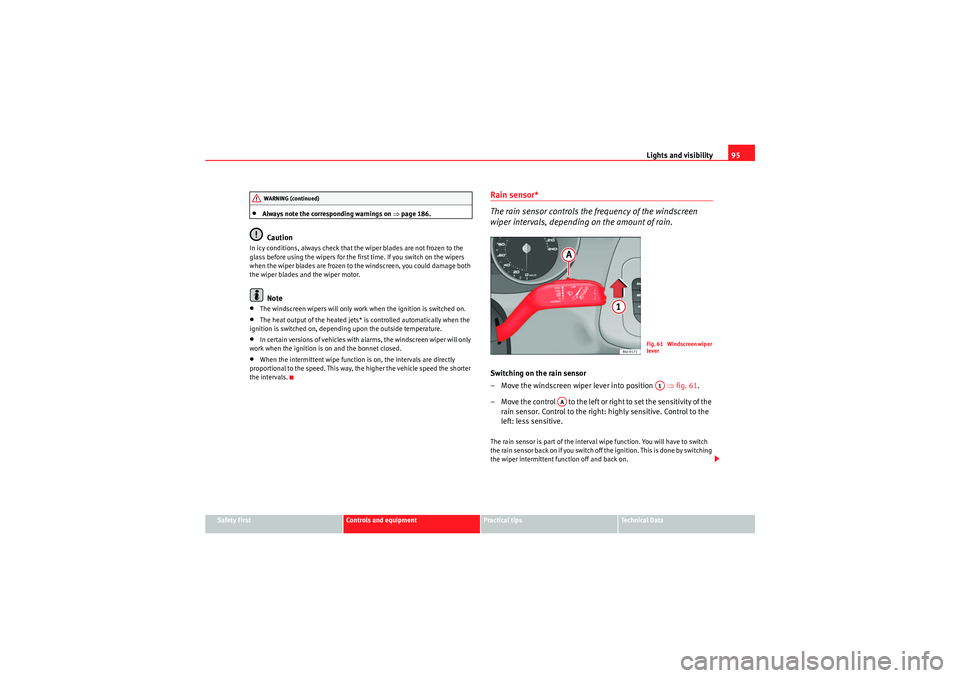
Lights and visibility95
Safety First
Controls and equipment
Practical tips
Technical Data
•Always note the corresponding warnings on ⇒page 186.Caution
In icy conditions, always check that the wiper blades are not frozen to the
glass before using the wipers for the first time. If you switch on the wipers
when the wiper blades are frozen to the windscreen, you could damage both
the wiper blades and the wiper motor.
Note
•The windscreen wipers will only work when the ignition is switched on.•The heat output of the heated jets* is controlled automatically when the
ignition is switched on, depending upon the outside temperature.•In certain versions of vehicles with alarms, the windscreen wiper will only
work when the ignition is on and the bonnet closed.•When the intermittent wipe function is on, the intervals are directly
proportional to the speed. This way, the higher the vehicle speed the shorter
the intervals.
Rain sensor*
The rain sensor controls the frequency of the windscreen
wiper intervals, depending on the amount of rain.Switching on the rain sensor
– Move the windscreen wipe r lever into position ⇒fig. 61 .
– Move the control to the left or right to set the sensitivity of the rain sensor. Control to the right: highly sensitive. Control to the
left: less sensitive.The rain sensor is part of the interval wipe function. You will have to switch
t h e r a i n s e n s o r b a ck o n i f y o u s w i tch o f f t h e i g n i t i o n . T h i s is d o n e b y s wi t ch i n g
the wiper intermittent function off and back on.
WARNING (continued)
Fig. 61 Windscreen wiper
leverA1
AA
IbizaSC_EN.book Seite 95 Mittwoch, 16. September 2009 12:11 12
Page 98 of 257
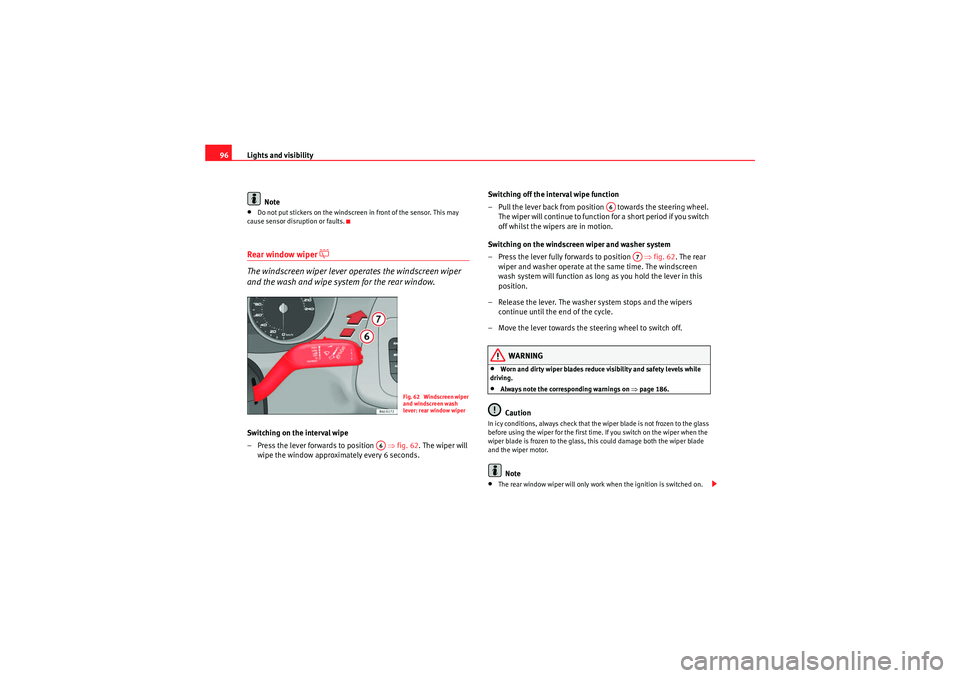
Lights and visibility
96
Note•Do not put stickers on the windscreen in front of the sensor. This may
cause sensor disruption or faults.Rear window wiper
The windscreen wiper lever operates the windscreen wiper
and the wash and wipe system for the rear window.
Switching on the interval wipe
– Press the lever forwards to position ⇒fig. 62 . The wiper will
wipe the window approximately every 6 seconds. Switching off the interval wipe function
– Pull the lever back from position towards the steering wheel.
The wiper will continue to function for a short period if you switch
off whilst the wipers are in motion.
Switching on the windscreen wiper and washer system
– Press the lever fully forwards to position ⇒fig. 62 . The rear
wiper and washer operate at the same time. The windscreen
wash system will function as long as you hold the lever in this
position.
– Release the lever. The washer system stops and the wipers continue until the end of the cycle.
– Move the lever towards the steering wheel to switch off.
WARNING
•Worn and dirty wiper blades reduce visibility and safety levels while
driving.•Always note the corresponding warnings on ⇒page 186.Caution
In icy conditions, always check that the wiper blade is not frozen to the glass
before using the wiper for the first time. If you switch on the wiper when the
wiper blade is frozen to the glass, this could damage both the wiper blade
and the wiper motor.
Note
•The rear window wiper will only work when the ignition is switched on.
Fig. 62 Windscreen wiper
and windscreen wash
lever: rear window wiper
A6
A6
A7
IbizaSC_EN.book Seite 96 Mittwoch, 16. September 2009 12:11 12
Page 100 of 257
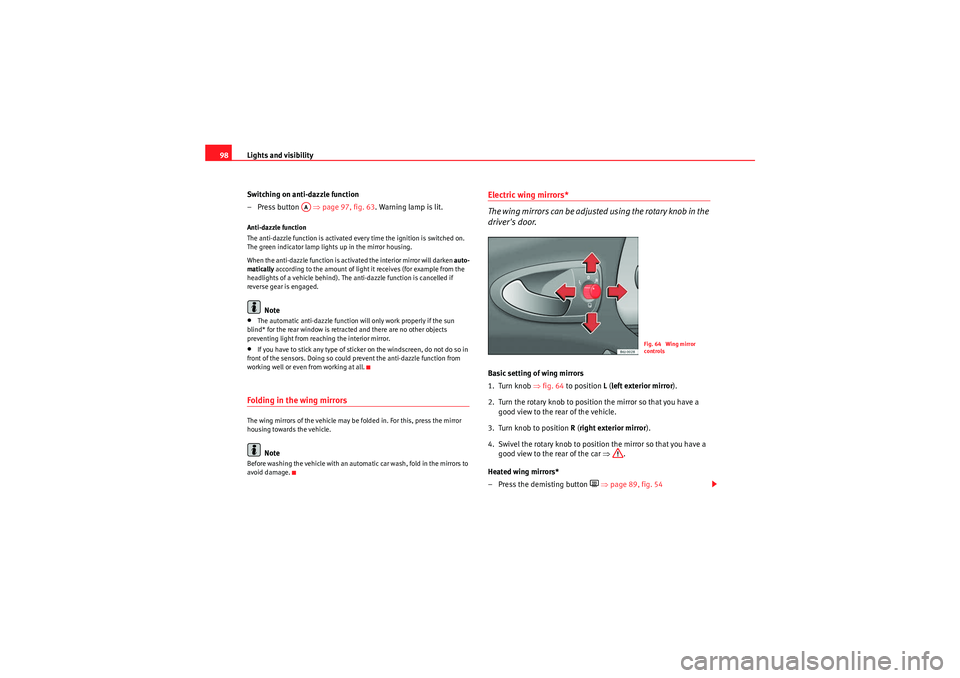
Lights and visibility
98
Switching on anti-dazzle function
–Press button ⇒page 97, fig. 63 . Warning lamp is lit.Anti-dazzle function
The anti-dazzle function is activated every time the ignition is switched on.
The green indicator lamp lights up in the mirror housing.
When the anti-dazzle function is activated the interior mirror will darken auto-
matically according to the amount of light it receives (for example from the
headlights of a vehicle behind). The anti-dazzle function is cancelled if
reverse gear is engaged.
Note
•The automatic anti-dazzle function will only work properly if the sun
blind* for the rear window is retracted and there are no other objects
preventing light from reaching the interior mirror.•If you have to stick any type of sticker on the windscreen, do not do so in
front of the sensors. Doing so could prevent the anti-dazzle function from
working well or even from working at all.Folding in the wing mirrorsThe wing mirrors of the vehicle may be folded in. For this, press the mirror
housing towards the vehicle.
Note
Before washing the vehicle with an automatic car wash, fold in the mirrors to
avoid damage.
Electric wing mirrors*
The wing mirrors can be adjusted using the rotary knob in the
driver's door.Basic setting of wing mirrors
1. Turn knob ⇒fig. 64 to position L ( left exterior mirror ).
2. Turn the rotary knob to positi on the mirror so that you have a
good view to the rear of the vehicle.
3. Turn knob to position R (right exterior mirror ).
4. Swivel the rotary knob to position the mirror so that you have a good view to the rear of the car ⇒.
Heated wing mirrors*
–Press the demisting button
⇒ page 89, fig. 54
AA
Fig. 64 Wing mirror
controls
IbizaSC_EN.book Seite 98 Mittwoch, 16. September 2009 12:11 12
Page 143 of 257
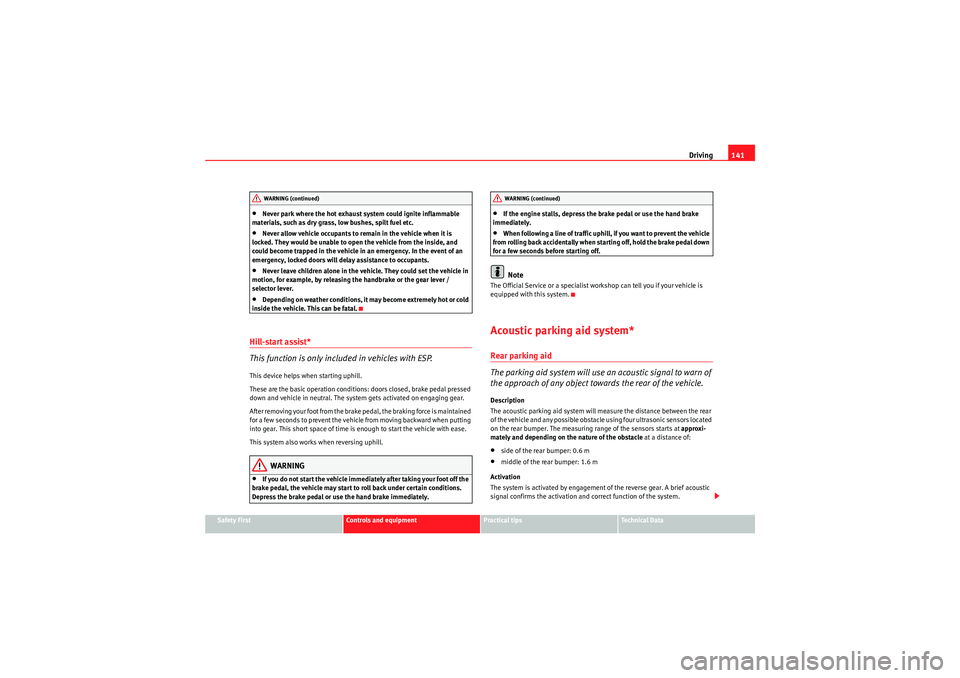
Driving141
Safety First
Controls and equipment
Practical tips
Technical Data
•Never park where the hot exhaust system could ignite inflammable
materials, such as dry grass, low bushes, spilt fuel etc.•Never allow vehicle occupants to remain in the vehicle when it is
locked. They would be unable to open the vehicle from the inside, and
could become trapped in the vehicle in an emergency. In the event of an
emergency, locked doors will delay assistance to occupants.•Never leave children alone in the vehicle. They could set the vehicle in
motion, for example, by releasing the handbrake or the gear lever /
selector lever.•Depending on weather conditions, it may become extremely hot or cold
inside the vehicle. This can be fatal.
Hill-start assist*
This function is only included in vehicles with ESP.This device helps when starting uphill.
These are the basic operation conditions: doors closed, brake pedal pressed
down and vehicle in neutral. The system gets activated on engaging gear.
After removing your foot from the brake pedal, the braking force is maintained
for a few seconds to prevent the vehicle from moving backward when putting
into gear. This short space of time is enough to start the vehicle with ease.
This system also works when reversing uphill.
WARNING
•If you do not start the vehicle immediately after taking your foot off the
brake pedal, the vehicle may start to roll back under certain conditions.
Depress the brake pedal or use the hand brake immediately.
•If the engine stalls, depress the brake pedal or use the hand brake
immediately.•When following a line of traffic uphill, if you want to prevent the vehicle
from rolling back accidentally when starting off, hold the brake pedal down
for a few seconds before starting off.Note
The Official Service or a specialist workshop can tell you if your vehicle is
equipped with this system.Acoustic parking aid system*Rear parking aid
The parking aid system will use an acoustic signal to warn of
the approach of any object towards the rear of the vehicle.Description
The acoustic parking aid system will measure the distance between the rear
of the vehicle and any possible obstacle using four ultrasonic sensors located
on the rear bumper. The measuring range of the sensors starts at approxi-
mately and depending on the nature of the obstacle at a distance of:•side of the rear bumper: 0.6 m•middle of the rear bumper: 1.6 m
Activation
The system is activated by engagement of the reverse gear. A brief acoustic
signal confirms the activation and correct function of the system.
WARNING (continued)
WARNING (continued)
IbizaSC_EN.book Seite 141 Mittwoch, 16. September 2009 12:11 12
Page 144 of 257
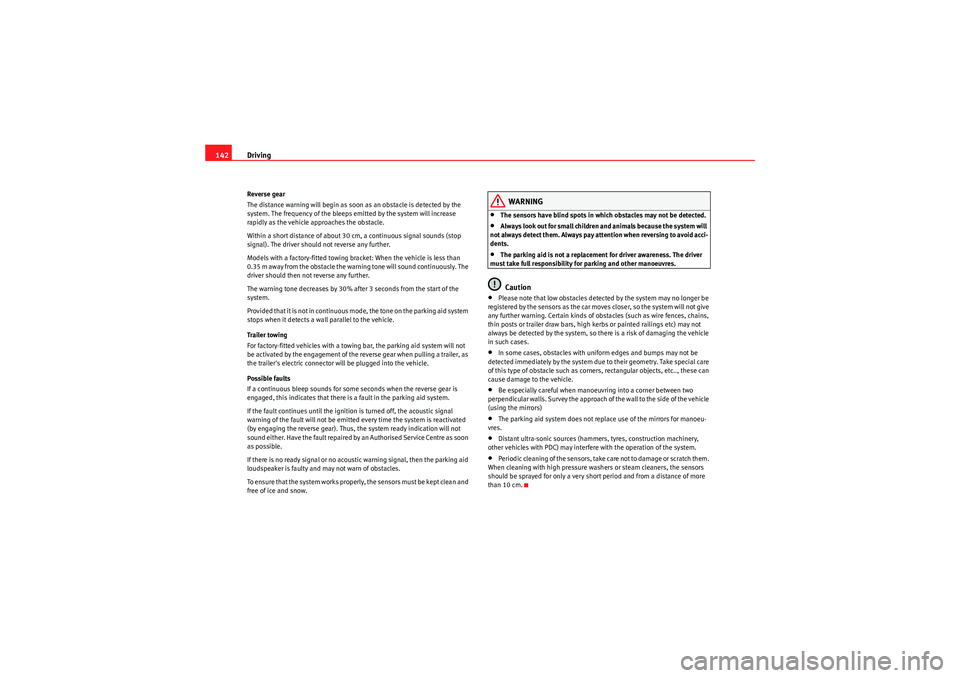
Driving
142Reverse gear
The distance warning will begin as soon as an obstacle is detected by the
system. The frequency of the bleeps emitted by the system will increase
rapidly as the vehicle approaches the obstacle.
Within a short distance of about 30 cm, a continuous signal sounds (stop
signal). The driver should not reverse any further.
Models with a factory-fitted towing bracket: When the vehicle is less than
0.35 m away from the obstacle the warning tone will sound continuously. The
driver should then not reverse any further.
The warning tone decreases by 30% after 3 seconds from the start of the
system.
Provided that it is not in continuous mode, the tone on the parking aid system
stops when it detects a wall parallel to the vehicle.
Trailer towing
For factory-fitted vehicles with a towing bar, the parking aid system will not
be activated by the engagement of the reverse gear when pulling a trailer, as
the trailer's electric connector will be plugged into the vehicle.
Possible faults
If a continuous bleep sounds for some seconds when the reverse gear is
engaged, this indicates that there is a fault in the parking aid system.
If the fault continues until the ignition is turned off, the acoustic signal
warning of the fault will not be emitted every time the system is reactivated
(by engaging the reverse gear). Thus, the system ready indication will not
sound either. Have the fault repaired by an Authorised Service Centre as soon
as possible.
If there is no ready signal or no acoustic warning signal, then the parking aid
loudspeaker is faulty and may not warn of obstacles.
To ensure that the system works properly, the sensors must be kept clean and
free of ice and snow.
WARNING
•The sensors have blind spots in which obstacles may not be detected.•Always look out for small children and animals because the system will
not always detect them. Always pay attention when reversing to avoid acci-
dents.•The parking aid is not a replacement for driver awareness. The driver
must take full responsibility for parking and other manoeuvres.Caution
•Please note that low obstacles detected by the system may no longer be
registered by the sensors as the car moves closer, so the system will not give
any further warning. Certain kinds of obstacles (such as wire fences, chains,
thin posts or trailer draw bars, high kerbs or painted railings etc) may not
always be detected by the system, so there is a risk of damaging the vehicle
in such cases.•In some cases, obstacles with uniform edges and bumps may not be
detected immediately by the system due to their geometry. Take special care
of this type of obstacle such as corners, rectangular objects, etc.., these can
cause damage to the vehicle.•Be especially careful when manoeuvring into a corner between two
perpendicular walls. Survey the approach of the wall to the side of the vehicle
(using the mirrors)•The parking aid system does not replace use of the mirrors for manoeu-
vres.•Distant ultra-sonic sources (hammers, tyres, construction machinery,
other vehicles with PDC) may interfere with the operation of the system.•Periodic cleaning of the sensors, take care not to damage or scratch them.
When cleaning with high pressure washers or steam cleaners, the sensors
should be sprayed for only a very short period and from a distance of more
than 10 cm.
IbizaSC_EN.book Seite 142 Mittwoch, 16. September 2009 12:11 12